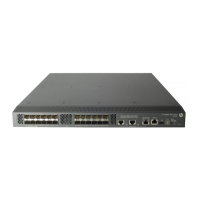28
3.
Turn on the device. You are prompted to press Enter if the device successfully completes the power-on
self-test (POST). A prompt such as <HP> appears after you press Enter, as shown in Figure 6.
Figure 6 Configuration page
4. Execute commands to configure the device or check the running status of the device. To get help,
enter ?.
Console login authentication modes
The following authentication modes are available for console port login: none, password, and scheme.
• none—Requires no username and password at the next login through the console port. This mode is
insecure.
• password—Requires password authentication at the next login through the console port. Keep your
password.
• scheme—Requires username and password authentication at the next login through the console port.
Authentication falls into local authentication and remote authentication. To use local authentication,
configure a local user and related parameters. To use remote authentication, configure the username
and password on the remote authentication server. For more information about authentication modes
and parameters, see Security Configuration Guide. Keep your username and password.

